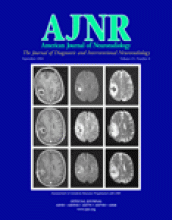Abstract
BACKGROUND AND PURPOSE: Identifying tissue at risk for infarction is an important goal of stroke imaging. This study was performed to determine whether pixel-based apparent diffusion coefficient (ADC) and signal intensity ratio are helpful diffusion-weighted (DW) imaging metrics to predict tissue at risk for infarction.
METHODS: Twelve patients presenting with acute hemispheric strokes underwent DW imaging within 7 hours of symptom onset. Region of interest (ROI), pixel-based ADC, and signal intensity analyses were performed at initial DW imaging to assess area of infarct growth, final infarct area, and normal tissue.
RESULTS: Pixel-based analysis was less accurate than ROI-based analysis for evaluating infarct growth or final infarct with ADC, ADC ratio, and signal intensity ratios. In pixel-based analysis, signal intensity ratios were better than ADCs or ADC ratios for identifying tissue at risk (accuracy, 67.4%) and for predicting final infarct (accuracy, 79.9%). Linear regression analysis demonstrated a strong correlation between lesion volume on quantitative DW images or ADC maps and final infarct volume (P < .001). When receiver operating characteristic (ROC) curves were used to determine optimal cutoffs for ADC and DW image values, the region of infarct growth was significantly correlated with only the mismatch between initial qualitative DW image and quantitative DW image signal intensity ratio (cutoff value, 1.19; R = 0.652; P = .022).
CONCLUSION: Pixel-based thresholds applied to ADC or DW image signal intensity maps were not accurate prognostic measures of tissue at risk. Quantitative DW images or ADC maps may provide added information not obtained by visual inspection of the qualitative DW image map.
- Copyright © American Society of Neuroradiology












